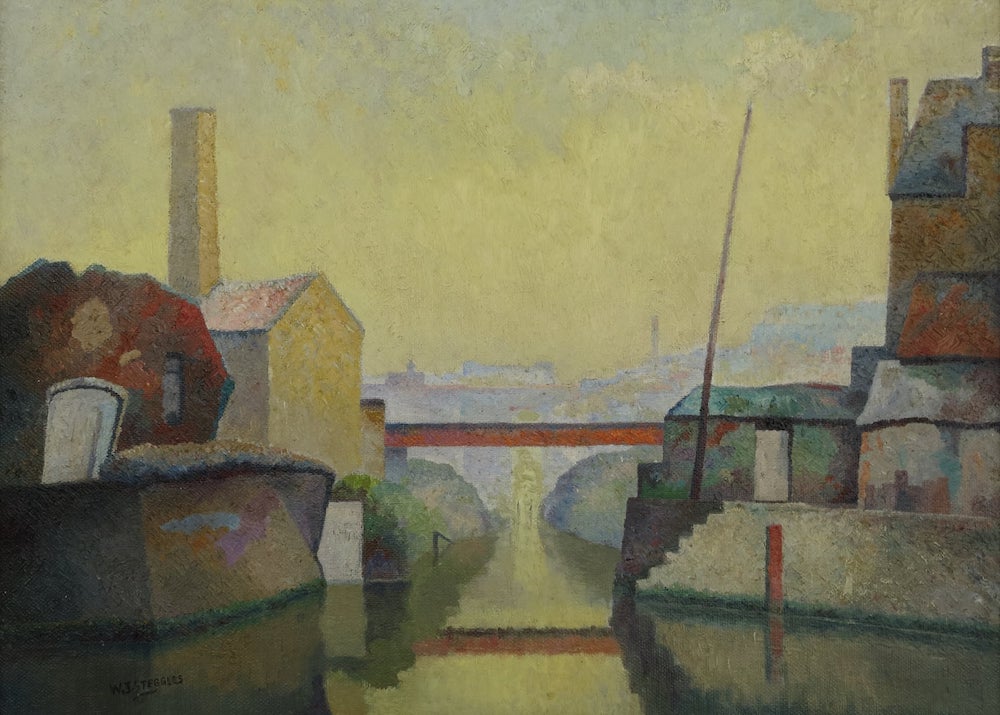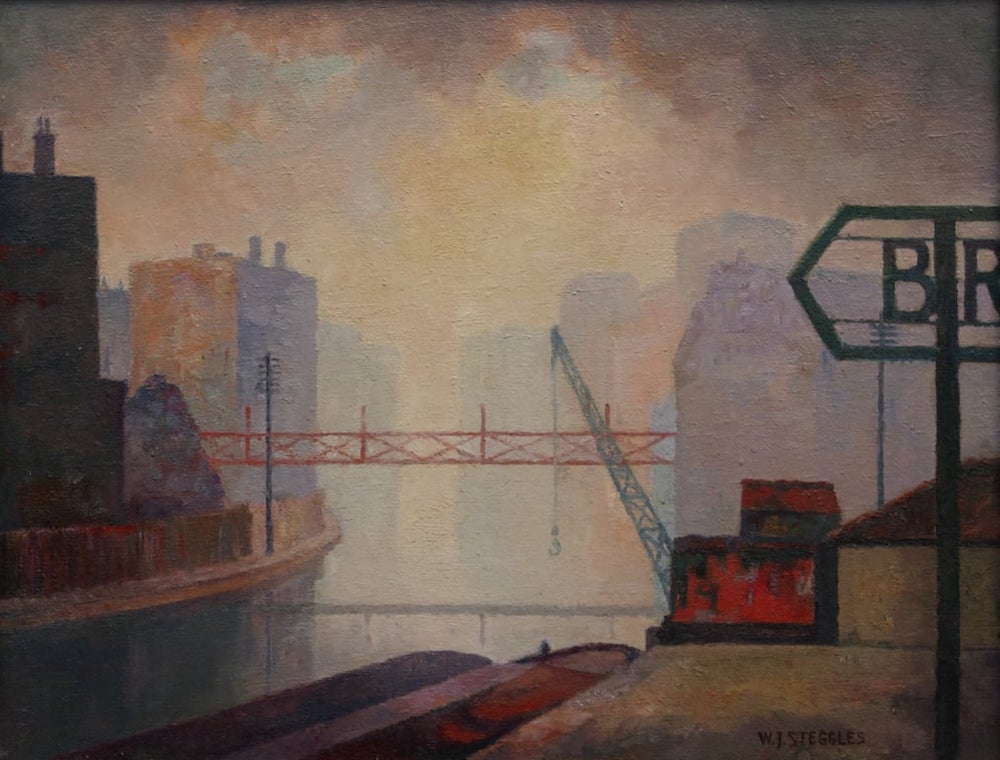Brothers in Art: Walter & Harold Steggles and the East London Group | Beecroft Art Gallery
I’ve been really interested in The East London Group’s paintings for a while - ever since I moved to Bow, slap bang in the middle of the neighbourhood depicted by these painters. This large exhibition puts over 100 paintings on show: that’s a hefty proportion of the total known surviving works from the Group. With the big majority of these in private collections, this exhibition represents a rare opportunity for an interested viewer. The public seems to agree; the gallery was pretty busy on the weekday morning I visited, and the exhibition’s been extended from an original close date in January to April, due to its popularity.
The East London Group came together in evening art classes taught by a local tutor, John Cooper, in the 1920s. Members were mostly - but not all - working class locals. Collectively, they achieved public acclaim in the years leading up to the Second World War, contributing to Mayfair gallery shows and a massive Shell ad campaign. Clearly the cognoscenti approved too: Walter Sickert supported the original evening classes, and two Group artists, Elwin Hawthorne and Walter Steggles, represented Britain at the 1936 Venice Biennale.

Walter Steggles’, Stratford, from 1938, is a representative example of the Group’s work. It’s a small oil painting of the neighbourhood: a section of the river Lea that meanders between what’s now Stratford High Street and the Olympic Park. Part of that area’s still used for industry, most of it’s posh flats, though. Plus, hilariously, the arena that animatronic Abba will perform in later this year.
Steggles’ 1930s vision of factories, steps, water and bridge is suffused in lemonish light. Even though he was painting the rough end of town, he and his counterparts in the Group tended to idealise what they painted, flattening out the area’s rough urban and industrial edges. Perhaps it was local pride? Either way, the Stratford factory tower in Steggles’ painting doesn’t belch out smoke. The water has no movement. The riverside is free from people. There’s a strikingly peaceful atmosphere.

Similarly, Elwin Hawthorne’s Bow Road, from 1931 features a single woman, waiting for a bus, and a man walking towards her. Another woman crosses the street, head down. She’s not in danger, because there’s no traffic at all on the road - which was, and remains, part of a major thoroughfare out of the City to the east. The roadside trees cast short shadows, so Hawthorne is depicting a moment somewhere towards the middle of the day. The unreality of the scene lends the painting the same uncanny atmosphere as Steggles’ Stratford - and these empty environments are repeated, again and again, in the Beecroft show. It’s no surprise that the Group’s work is often compared to Edward Hopper, that master of depopulated urban scenes.
But there’s something uniquely London about this particular Bow Road, and not just because I immediately recognised that exact bridge, which is a few metres from my flat. These days, the railway over the bridge is used by Crossrail trains on their test runs. There’s a segregated bike lane in front of the bus stop, and a Co-op just out of frame to the left. But the road and the bridge are still there, pretty much unchanged.
And there’s something about Hawthorne’s skeletal trees, those spindly chimneys, and especially that dusty-coloured sky that, to this Londoner at least, is quintessentially, London. In 1931, R H Wilenski, an art critic contemporary of the Group, mentioned the “certain wistfulness” of the “cool, frail London light” that impressed the city’s visitors. (That quote is featured in a Financial Times review of the Beecroft show.) In a vitrine in the gallery, there’s a cutting of a more cutting contemporary review of the group’s work, from 1938. Headlined “WORTHY PAINTERS”, Steggles and co’s paintings are described as “prim and dry and modest”.
I’m annoyed by the patronising tone of the 1938 review, but I have to also admit there’s something “prim” about the quietude and idealised nature of the Group’s scenes. People and pollution would spoil the view. Isn’t that a bit worthy?

There’s definitely a sort of primness about Walter Steggles’ Brymay Wharf, pictured above. The painting’s clouds are like candy floss, the sides of the buildings adorably pastel-toned, the skeletal metal bridge and sign lending a pleasing structure to the whole. In a nearby cabinet is the source photo from which Steggles painted. It’s recognisably from the same scene, but the fetid-looking canal is shrouded in disgusting-looking fumes, the sky sickly with smog.
Along with Hopper, I’m reminded of Charles Sheeler, George Ault and their Precisionist cohorts, from across the Atlantic, who worked at the same time. Sheeler’s quiet, clean scenes of factories and industry remain deeply appealing. But any claims to realism are undermined by Manhatta, the film Sheeler made with photographer Paul Strand, which showed the industrial landscapes he worked in as, in reality, unbelievably filthy. It’s an industrial filth that was pitilessly depicted at the time elsewhere in Europe, by Mario Sironi and others. The Americans and the Londoners chose to emphasise light and structure instead.
As the Financial Times reviewer points out, the Group captured the very specific London light described by Wilenski - a light that’s fragile and withholding, sometimes dusty, sometimes faded. It’s a light that present day Londoners recognise and respond to. I think that light’s a big reason why so many people, me included, are taking the train from Liverpool Street and Stratford to Southend-on-Sea, to visit the show.
It’s also a London light I find in contemporary work from Mike Silva and Jock McFadyen, the latter of whom has a show on at the Royal Academy, that I also visited and enjoyed this week.
McFadyen works in almost exactly the same area as The East London Group - that post-industrial sliver of city, sliced up by train tracks and canals, from Bethnal Green to Stratford. Instead of empty roads and factories, he portrays what’s in the area now: from petrol stations to council blocks to the Olympic Stadium and Orbit. Unlike the best-foot-forward East London Group, he enjoys painting the deliberate ugliness of urban detritus and waste: his factories feature blown-out windows and grime.
But, above all this, there’s that same sky: the cool, frail light. It’s that light that gave me a similar feeling of recognition, of a weird sort of affirmation - both in these grand RA rooms, and at the gallery in Southend. A feeling of… no place like home!
Brothers in Art: Walter & Harold Steggles and the East London Group is at Beecroft Art Gallery (Southend-on-Sea). 11 September 2021 - 03 April 2022. Jock McFadyen RA: Tourist without a Guidebook is at the Royal Academy (London). 05 February - 10 April 2022